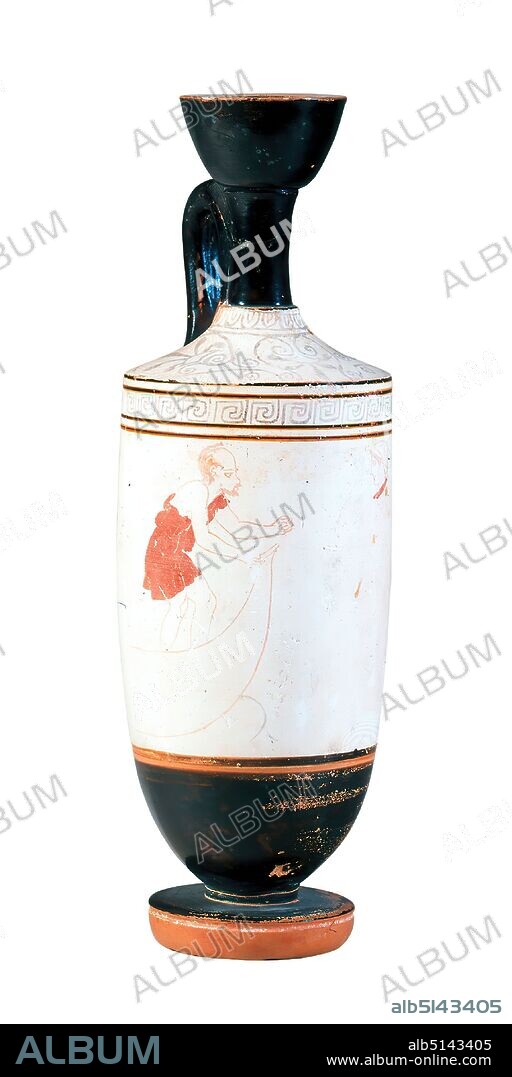alb5143405
Painter of the Lekythos Cambridge 28.2, Lekythos (Charon and deceased), clay, quickly turned, fired (ceramic), painted (ceramic), cold painting, clay, Total: Height: 20.7 cm; Diameter: 6.7 cm; Muzzle diameter: 4 cm; Diameter: 4.8 cm (foot), Pottery, Charon, the ferryman, Acheron, Meander, High Classical (Greek antiquity), In Greek antiquity, all vessels for ointment or perfume oils were called lekyths; today the term is used for this special type of vessel. Around 530/520 BC, the so-called white-ground technique was developed, which probably served to imitate more valuable materials such as marble, alabaster, ostrich eggs or ivory. At the same time, it made possible a multi-colored painting. The iconography of the white-ground lekyths is dominated by depictions of graves and death. Here, the ferryman of the dead Charon approached with his neck-like tail from the left to pick up a deceased girl or young woman waiting on the shore. The boat is shown in only a few lines. Charon stands in a slightly stooped position, his left hand clenched, his right hand stretched out and open. He wears a short, reddish-brown coat, which leaves his right shoulder free. He has a high forehead bald head with sparse, pale red occipital hair, a small hooked nose and a pointed chin beard. The young woman is wrapped in a long coat that also covers her arms and legs. On her head she wears a hood, which is held together by ribbons. The shoulder is decorated with circumscribed palmettes and tendrils; it is closed at the top by an egg stick. The meander below the shoulder is limited to the width of the figurative scene, while the golden-brown rings surround it.

|
Zu einem anderen Lightbox hinzufügen |
|
Zu einem anderen Lightbox hinzufügen |



Haben Sie bereits ein Konto? Anmelden
Sie haben kein Konto? Registrieren
Dieses Bild kaufen.
Nutzung auswählen:

Untertitel:
Siehe automatische Übersetzung
Painter of the Lekythos Cambridge 28.2, Lekythos (Charon and deceased), clay, quickly turned, fired (ceramic), painted (ceramic), cold painting, clay, Total: Height: 20.7 cm; Diameter: 6.7 cm; Muzzle diameter: 4 cm; Diameter: 4.8 cm (foot), Pottery, Charon, the ferryman, Acheron, Meander, High Classical (Greek antiquity), In Greek antiquity, all vessels for ointment or perfume oils were called lekyths; today the term is used for this special type of vessel. Around 530/520 BC, the so-called white-ground technique was developed, which probably served to imitate more valuable materials such as marble, alabaster, ostrich eggs or ivory. At the same time, it made possible a multi-colored painting. The iconography of the white-ground lekyths is dominated by depictions of graves and death. Here, the ferryman of the dead Charon approached with his neck-like tail from the left to pick up a deceased girl or young woman waiting on the shore. The boat is shown in only a few lines. Charon stands in a slightly stooped position, his left hand clenched, his right hand stretched out and open. He wears a short, reddish-brown coat, which leaves his right shoulder free. He has a high forehead bald head with sparse, pale red occipital hair, a small hooked nose and a pointed chin beard. The young woman is wrapped in a long coat that also covers her arms and legs. On her head she wears a hood, which is held together by ribbons. The shoulder is decorated with circumscribed palmettes and tendrils; it is closed at the top by an egg stick. The meander below the shoulder is limited to the width of the figurative scene, while the golden-brown rings surround it.
Persönlichkeiten:
Bildnachweis:
Album / quintlox
Freigaben (Releases):
Bildgröße:
2160 x 4320 px | 26.7 MB
Druckgröße:
18.3 x 36.6 cm | 7.2 x 14.4 in (300 dpi)
Schlüsselwörter:
BEIN • BEIN, ANATOMIE • BEINE • CHARON • CHARON, FAEHRMANN HADES • EINFUSSER • EINFÜSSER • FAEHRMANN • FUSS • FÄHRMANN • IKONOGRAPHIE • KERAMIK • KOPF (ANATOMIE) • KOPF • KÜSTENLANDSCHAFT • LAUB • LEKYTHOS • MAEANDER • MALER • MARMOR • MÄANDER • SCHULTER • STEILUFER • STEINGUT • TOD • TODESFALL • TOEPFEREI • TOEPFERWARE • TON • TUMBAS • TÖPFEREI • UFER • ZEIT • ZEITGENÖSSISCH


 Pinterest
Pinterest Twitter
Twitter Facebook
Facebook Link kopieren
Link kopieren Email
Email
